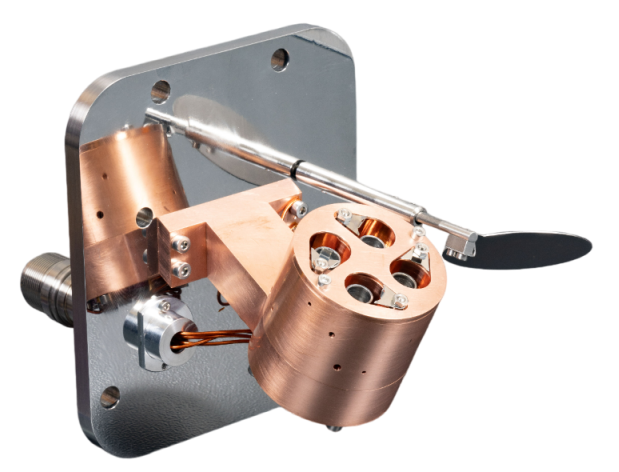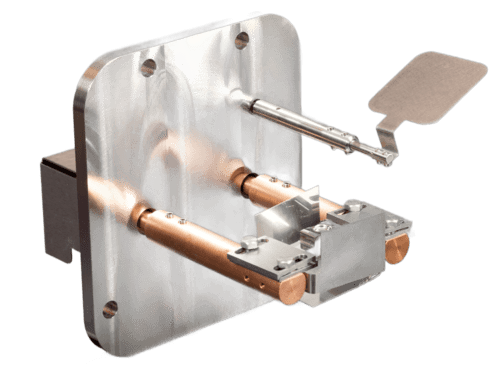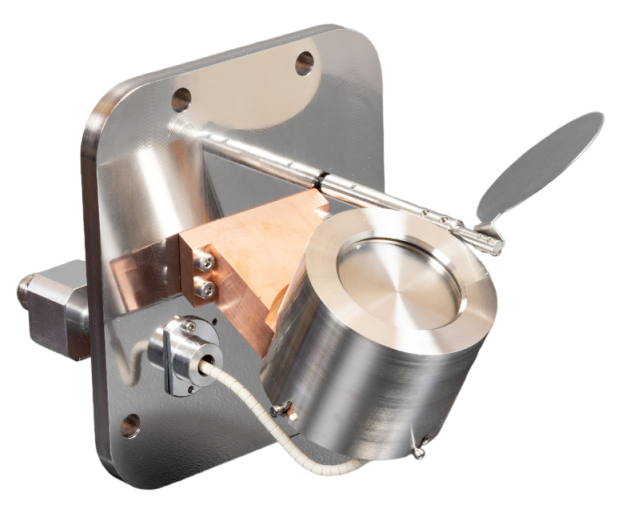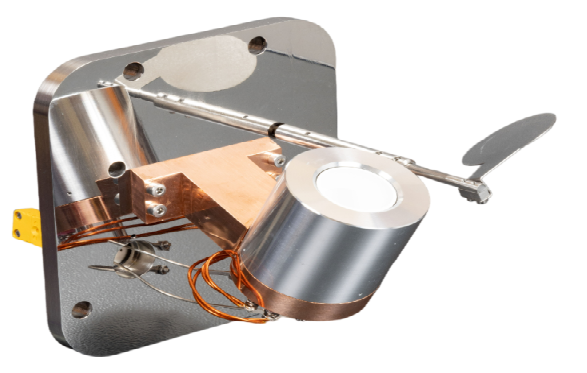The HEX Series facilitates a range of deposition sources. These can be mixed and matched to the end-user’s discretion, as well as being switched between the HEX and HEX-L models. Robustly designed and easily maintained, Korvus Technology’s deposition sources are an ideal accompaniment to the HEX and HEX-L PVD Systems.
TAU | E-Beam Evaporation
Our high-accuracy (sub-monolayer) mini E-beam evaporators are ideal for ultra-thin film deposition with reliable process control. Material can be evaporated from rods or material held in a crucible.
The TAU E-Beam evaporation source is a ‘mini’ source, meaning that it doesn’t use the beam-bending magnets found in other, larger electron beam evaporation sources. The TAU produces a high voltage at the target material while using the low voltage at the tungsten emission filament to produce a direct heating and evaporative effect.
One of the most significant concerns with the e-beam evaporation process is the heat generated during the vaporisation stage. The TAU uses an enclosed head that reduces the thermal load in the vacuum chamber, allowing for coating at relatively low substrate temperatures. This reduced thermal energy makes the TAU a useful tool in lift-off processes and the coating of sensitive substrates.
Learn More: Electron Beam Evaporation Explained


TES | Thermal Evaporation
The single thermal boat source allows for the integration of a range of thermal boats for the deposition of both metals and organics/polymers
The Korvus TES thermal boat sources allow quick removal of the sources to allow replenishment of the evaporant material. Boats and filaments can also be easily and rapidly replaced.
The TES sources are available as a single-source per flange unit. Optionally, thermocouples may be mounted to monitor the boat temperature. Each source can be equipped with a manual or automatic shutter.
Multiple sources may be accommodated in one system. The sources can also be used in conjunction with other techniques such as sputtering, e-beam deposition and low-temperature sources.
FISSION | Magnetron Sputtering
Designed for 2" diameter targets, the sputter sources are equipped with SmCo magnets and accept targets with thickness ranging from 0.5 to 6mm of non-magnetic materials and up to 1mm for magnetic materials.
The Fission series of magnetron sputtering systems allows users to switch between thin film DC and RF sputtering without specialised tools or lengthy downtime. The Fission deposition source is a module of the modular HEX system that uses quick-release connectors for cooling and water connections, making set-up simple and fast. The HEX system provides the framework for multiple physical vapour deposition techniques, including DC/RF sputtering.
The system accommodates reactive sputtering through the introduction of the reactive gas directly into the chamber or via a separate gas feed. We recommend using the separate feed to maintain the correct partial pressure of the reactive gas at the target.
The Fission series allows the sputtering of all solid metals, magnetic materials, insulators, and semiconductors and can even process multiple sources to grow a composite thin film.
The HEX system even supports high-power impulse magnetron sputtering (HiPIMS), resulting in the target molecules arriving at the substrate as ions instead of neutral atoms. The main advantage of HiPIMS is that it allows for excellent control over the film’s microstructure, phase composition, and optical properties.


ORCA | Organic Evaporation
The ORCA organic deposition source is designed to operate between 50 and 600 C to allow sensitive organic materials to be evaporated with precise control
The ORCA low-temperature evaporation source employs active cooling of the crucible to ensure that the heating process is balanced by a strong opposing cooling process which results in excellent temperature stability and control.
The crucible is constructed from high thermal-conductivity material, ensuring no hot-spots arise which could distort the evaporation rate. Optionally, alumina or graphite liners may be employed. The crucible (complete with liner if fitted) is easily removed/swapped without the need for any tools, although this is often not necessary since access to the source in order to refill the crucible is rapid and simple.
The K-type thermocouple is inserted into the body of the crucible, giving much more accurate readings than typical touch-contact arrangements. The source is supplied with a power unit coupled with a PID controller tuned to low-temperature operation.
The source may be used in conjunction with sputter sources, e-beam sources, thermal sources and others. Thermal cross-talk is kept to a minimum through the cooled shielding cap. The ORCA is also perfectly paired with our temperature gradient sample stage allowing precise temperature control of the substrate.
